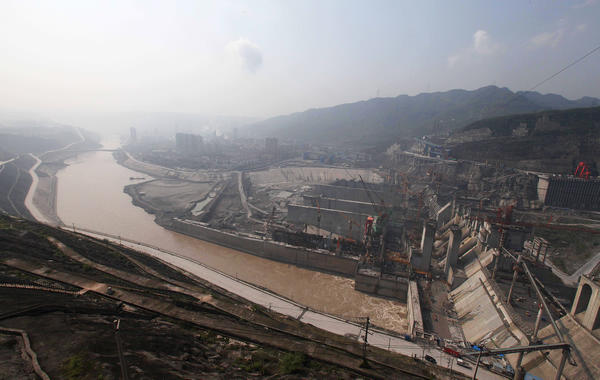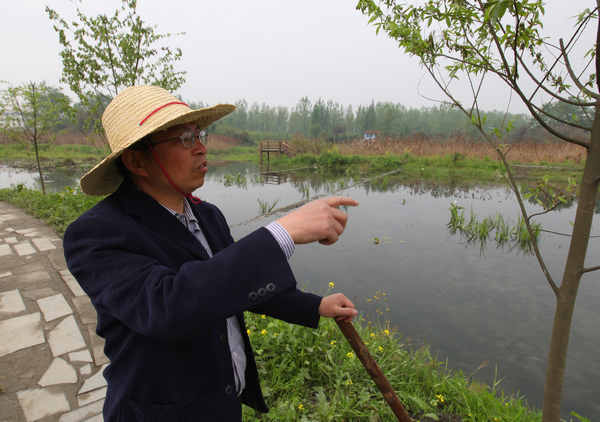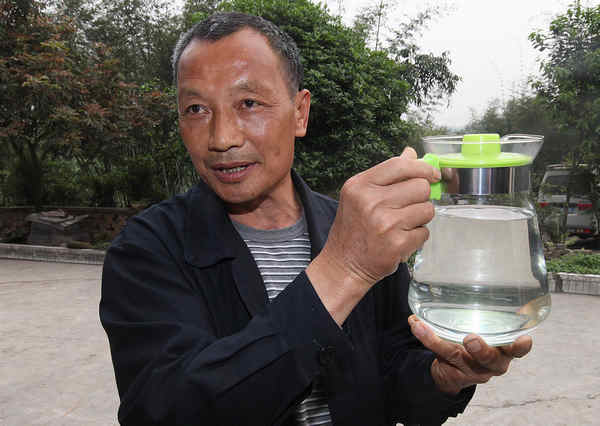People tap into a healthier life
记者 武文聪
Projects ensure safe drinking water, reports Wu Wencong in Sichuan.
Li Linxu pointed to the mountain opposite his farmhouse where clean spring water flows into his village. "That's the source of our drinking water now," Li said.
"The water we used to drink tasted muddy, no matter whether it was being used to cook rice or make tea. If I had continued to use it no tourists would have come to eat at my farmhouse."
The 40-year-old, who runs a small business providing tourists with food and accommodation, lives in a small village called Tasha in Yibin, a city at the west end of the Yangtze River in Sichuan province. Li and his fellow villagers have only had access to tap water since 2005.
They are among almost 20 million people in Sichuan's rural areas whose concerns about the safety of their drinking water have been alleviated during the past five years. The village's small pond that used to provide all their water has long dried up.
"Ducks swam in it and we used to drink the untreated water," said Li. "Some people had diarrhea occasionally after drinking the water."
According to a 2004 survey conducted by the provincial government, more than 31 million people in rural areas had no access to safe drinking water.
In a bid to solve the problem, more than 9 billion yuan ($1.43 billion) was invested in the province over the next five years to solve the problem.
With the construction of 300,000 water supply projects in rural areas, about two-thirds of those previously affected are now guaranteed clean drinking water. That increased the total percentage of those with access to safe drinking water in rural areas to 77.4 percent in 2011 from 53.3 percent in 2004.
Zhang Lei, deputy head of Sichuan Provincial Bureau of Rural Water Resources, said that quality is the core of the four criteria required for safe drinking water. The other requirements are: the daily quantity of water per capita has to reach a certain level; the water should be provided continuously; and safe drinking water should be accessible within a round trip of roughly 20 minutes.
The results of environmental monitoring show that the percentage of centralized drinking water sources in Sichuan province that attained the required standard of quality rose to 81.2 percent in 2010 from 68.5 percent in 2006.
One of the most effective methods that enabled that increase is a project called "Head of the River", whereby leaders at different levels of government are appointed as "heads" of local rivers and are therefore responsible for the treatment of pollution. Those who fail to meet the standards set at the beginning of each year risk losing their positions.
The method was first implemented in 2007, in Wuxi, in Jiangsu province. Following its adoption, the percentage of monitoring points that reached the required standards surged from 53 percent to more than 70 in the first six months.
Sichuan also recorded impressive figures when the scheme was introduced in the province. Yang Rong, head of the pollution prevention and control department at the Sichuan Provincial Bureau of Environmental Protection, said that by 2009 all the monitoring points on the Tuojiang and Minjiang rivers recorded levels of cleanliness that reached the national standard. Only five years before, in 2004, the percentage along the Tuojiang River was zero.
One regime that is unique to the province involves the imposition of a fine managed by the provincial department of finance. If an upstream city pollutes river water and then allows it to flow through cities downstream, it faces a heavy fine. The provincial government also reallocates funds allotted to the upstream city and gives a share to those affected downstream
The basic fine ranges from 200,000 to 500,000 yuan, and can be doubled and redoubled if pollutants, such as ammonia nitrogen, are discovered or if levels of chemical oxygen demand - an important indicator of how heavily the water is polluted - exceed the safety levels, according to Yang.
Six cities and counties paid a total of almost 12 million yuan in fines from September to December 2011, Sichuan Daily reported in February.
The population factor
Despite equally strict quality requirements in both cities and rural areas, one of the greatest differences in the provision of safe drinking water is the discrepancy of population distribution.
"In rural areas such as Sichuan, where a certain percentage of the population lives in inaccessible places in the mountains, the discrepancy becomes massive," said Zhang. "In some rural areas, the population density can be as low as 700 people per square kilometer."
Zhu Bing, deputy head of the Sichuan provincial department of water resources, said the government had previously set up many scattered small-scale water supply projects because of the low population density in many rural areas. "But we learned that although construction of small-scale projects is much easier, the post-regulatory work on water quality becomes a major headache," he said.
As a result, the construction of large-scale centralized water supply plants has turned out to be indispensable to future development. "In the next five years, extra centralized water supply plants will be built to cover more than 70 percent of the population in rural Sichuan," said Zhu.
In 2010, Gou Zhuyao's family was among the first in Dashiqiao village, Suining city, to drink tap water. "We used to pump water from the well in our yard. It tasted bitter, not as sweet as the tap water now," said the 75-year-old who lives with her 80-year-old husband.
As the other family members are away working in South China's Guangdong province, the elderly couple pays about 12 yuan per month for tap water, that's about 1.8 yuan per cubic meter.
When asked about the fee, Gou smiled and said that it wasn't a burden on her family, "Pumping water from the well also cost (in terms of) electricity."
County versus city
However, not all villagers in Sichuan welcome paying the fee for convenient tap water. Zhang said the average tap water fee in the rural areas is 2 yuan per cu m, twice that in the downtown areas.
"In some remote areas, the fee can be as high as five yuan per cu m," he said. "It is far too much for farmers without a fixed income to cover."
Zhang added that the price is a result of the high unit cost of water delivery to rural areas. For example, a 1-km-long pipe may provide water for 10,000 people in a city, but the same pipe would only cover a few hundred in the rural areas. "We hope the water plants can run in virtuous circles by themselves and not be a burden to the government in the future," said Zhang.
Another factor raising the price of water is the high cost of laying pipes in the mountains. "The standard national subsidy is 400 yuan per person in Sichuan, but in many cases, especially in the mountain plateau area in the west of the province, at least 800 yuan is needed to solve the problem,"
Zhang said that even if the province had sufficient funds, about 20 percent of the population would still be denied access to a centralized water supply because of the geography of the area. The only way to tackle the problem is by using diverse water supplies from wells and cisterns.
Zhu Bing, from the Sichuan department of water resources, said the government has a number of projects in readiness, including the selection of a "responsible person" to ensure the safety of the wells and cisterns and also the water quality. Local sanitary and water resource departments will also be urged to monitor water quality on a monthly basis to make sure that the prevailing standards are adhered to.
Sichuan plans more hydro projects to aid expanding cities
When it is finished in 2015, the Xiangjiaba hydropower plant will be the third-largest in China, next only to the Three Gorges plant in Chongqing and Xiluodu in Sichuan, which is also under construction.
By the end of 2011, Sichuan had completed roughly 640,000 hydro projects. At least one large or medium-sized project has started every month since the beginning of 2010.
 |
|
The Xiangjiaba hydropower plant, currently under construction. When completed in 2015, the facility will be the third-largest in China. Liu Gang / for China Daily |
In the next five years, 13 large and around 60 medium-sized projects will begin, with the aim of supplying all the water-deficient areas in the province.
Wen Ting, deputy head of the education center of the Sichuan Provincial Bureau of Environmental Protection, said many people believe that the province has an abundance of water resources, but many cities and counties suffer from seasonal shortages and pollution.
Take Neijiang as an example. Situated in the middle of the province, this large city gets its water from the Tuojiang River, which runs through it. "In the dry season, cities on the upper reaches of the river often store water in reservoirs, so the amount left for Neijiang is negligible," said Wen.
In March 2004, the Tuojiang River was severely contaminated after an accident at a chemical factory in Chengdu, the capital of Sichuan. The contamination left millions of residents in cities downstream of Chengdu, Neijiang among them, without safe tap water for almost three weeks.
"There are so many cities and chemical plants along the river. That poses a potential safety hazard to the people of Neijiang," said Zeng Wanming, secretary of the Neijiang municipal Party committee. "The only solution to this problem is the irrigation project at Xiangjiaba, which will transfer water from the Jinsha River to Neijiang."
"The urbanization and industrialization of cities is not preventable," said Wen from the provincial environmental protection bureau. Many major cities in the province are planning to expand their populations by least 1 million, but those plans have been severely hampered by a lack of drinking water.
A planned irrigation project involving the Xiangjiaba plant is currently awaiting approval from the central government, and it's estimated that at least 5 million people in the provinces of Sichuan and Yunnan will benefit if it gets the green light.




